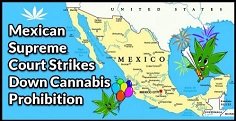Mexico is fast approaching its October 23, 2019 recreational marijuana legalization deadline. This sets Mexico to become the third country to legalize recreational marijuana after Canada and Uruguay.

Medical marijuana with tetrahydrocannabinol (THC) content under 1.0% has been legal in Mexico since June 2017.Mexico’s medical cannabis market is predicted to grow 27.7% annually to $249.6 million by 2025.
Legalizing recreational marijuana will bring several benefits,particularly reducing black-market activities associated with marijuana.
Legalization will encourage tax-paying businesses to enter, boosting the Mexican government’s tax revenue.Legalization will bring in $1.2 billion in tax revenue for Mexico and save up to $200 million in enforcement costs,and promote associated activities that create employment in Mexico.
Climate will be a significant factor for Cannabis & Industrial Hemp growers,so the following countries will be significant players.
COLOMBIA
Colombia offers the perfect climate for cultivation year-round as well as robust cannabis legislation.
JAMAICA
Jamaica presents a significant opportunity to obtain unique Cannabis strains, cultivate high-end flower to obtain higher quality, more effective, medicinal products.
Mexico
The country’s climate is more favorable, and production and labor costs are lower than neighbouring USA.There is the real possibility of Mexico exporting legal cannabis & Hemp to its neighbour.
North America
Cannabis & Industrial Hemp growers are well established here,but as stated above could face stiff cost competition from neighbouring Mexican cultivators.
From plant cultivation to product development
Nearly 25 years ago, researchers discovered two flavonoids produced by the cannabis plant: cannflavin A and cannflavin B.
Research at the time verified that these compounds were, gram-for-gram, 30 times more effective at reducing inflammation than aspirin.
And they work differently than opioids in managing pain.
Opioids – like hydrocodone, codeine, and fentanyl – work by blocking the brain’s pain receptors. They do nothing to treat the cause of the pain, but Cannflavins go straight to the source of the pain – inflammation.
However,cannflavin A and B are only produced in small amounts by the cannabis plant.
But researchers from the University of Guelph have discovered how to produce the molecules cannflavin A & B in large quantities, and one company now has the patent on the process.
The researchers studied the cannabis genome and found the pathways responsible for making the cannflavins. This discovery allowed them to take those genes and use them to modify microorganisms and manufacture these compounds in abundance through biosynthesis.
Anahit International, a private,Toronto-based company, has licensed a patent from the University of Guelph that covers the process and will work on scaling up the technology.
Research is continuous with exciting prospects.
I believe Cannabis and its uncontroversial sister plant - Industrial Hemp - will produce powerful natural medicinal products to lessen the need for synthetic chemical medication.
There is a place for both orthodox and alternative plantl source medicines,but the opioid addiction crisis highlights the need for a better balance.
Nature is the best healer and should be the first resort in the first aid cabinet.
CBD from Industrial Hemp is Natures NHS - 'Natural Health Source' for 'Health without the Highs'

